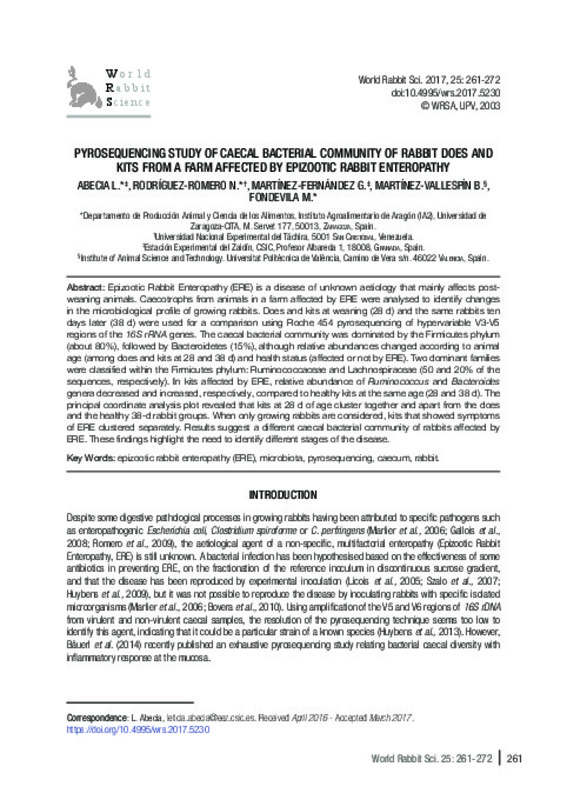JavaScript is disabled for your browser. Some features of this site may not work without it.
Buscar en RiuNet
Listar
Mi cuenta
Estadísticas
Ayuda RiuNet
Admin. UPV
Pyrosequencing study of caecal bacterial community of rabbit does and kits from a farm affected by epizootic rabbit enteropathy
Mostrar el registro sencillo del ítem
Ficheros en el ítem
| dc.contributor.author | Abecia, L.
|
es_ES |
| dc.contributor.author | Rodríguez-Romero, N.
|
es_ES |
| dc.contributor.author | Martínez-Fernández, G.
|
es_ES |
| dc.contributor.author | Martínez Vallespín, Beatriz
|
es_ES |
| dc.contributor.author | Fondevila, M.
|
es_ES |
| dc.date.accessioned | 2017-09-29T08:50:53Z | |
| dc.date.available | 2017-09-29T08:50:53Z | |
| dc.date.issued | 2017-09-28 | |
| dc.identifier.issn | 1257-5011 | |
| dc.identifier.uri | http://hdl.handle.net/10251/88257 | |
| dc.description.abstract | [EN] Epizootic Rabbit Enteropathy (ERE) is a disease of unknown aetiology that mainly affects post-weaning animals. Caecotrophs from animals in a farm affected by ERE were analysed to identify changes in the microbiological profile of growing rabbits. Does and kits at weaning (28 d) and the same rabbits ten days later (38 d) were used for a comparison using Roche 454 pyrosequencing of hypervariable V3-V5 regions of the 16S rRNA genes. The caecal bacterial community was dominated by the Firmicutes phylum (about 80%), followed by Bacteroidetes (15%), although relative abundances changed according to animal age (among does and kits at 28 and 38 d) and health status (affected or not by ERE). Two dominant families were classified within the Firmicutes phylum: Ruminococcaceae and Lachnospiraceae (50 and 20% of the sequences, respectively). In kits affected by ERE, relative abundance of Ruminococcus and Bacteroides genera decreased and increased, respectively, compared to healthy kits at the same age (28 and 38 d). The principal coordinate analysis plot revealed that kits at 28 d of age cluster together and apart from the does and the healthy 38-d rabbit groups. When only growing rabbits are considered, kits that showed symptoms of ERE clustered separately. Results suggest a different caecal bacterial community of rabbits affected by ERE. These findings highlight the need to identify different stages of the disease. | es_ES |
| dc.description.sponsorship | This work was supported by Project AGL 2006-07596 (Ministry of Education and Science, Spain), with participation of the Department of Industry and Innovation of the Government of Aragon and the European Social Fund. The stage of N. Rodríguez-Romero in the University of Zaragoza was financed by a Doctoral fellowship from the Universidad Nacional Experimental del Táchira (San Cristóbal, Venezuela). | |
| dc.language | Inglés | es_ES |
| dc.publisher | Universitat Politècnica de València | |
| dc.relation.ispartof | World Rabbit Science | |
| dc.rights | Reserva de todos los derechos | es_ES |
| dc.subject | Epizootic Rabbit Enteropathy (ERE) | es_ES |
| dc.subject | Microbiota | es_ES |
| dc.subject | Pyrosequencing | es_ES |
| dc.subject | Caecum | es_ES |
| dc.subject | Rabbit | es_ES |
| dc.title | Pyrosequencing study of caecal bacterial community of rabbit does and kits from a farm affected by epizootic rabbit enteropathy | es_ES |
| dc.type | Artículo | es_ES |
| dc.date.updated | 2017-09-29T07:00:09Z | |
| dc.identifier.doi | 10.4995/wrs.2017.5230 | |
| dc.relation.projectID | info:eu-repo/grantAgreement/MEC//AGL2006-07596/ | es_ES |
| dc.rights.accessRights | Abierto | es_ES |
| dc.contributor.affiliation | Universitat Politècnica de València. Instituto de Ciencia y Tecnología Animal - Institut de Ciència i Tecnologia Animal | es_ES |
| dc.description.bibliographicCitation | Abecia, L.; Rodríguez-Romero, N.; Martínez-Fernández, G.; Martínez Vallespín, B.; Fondevila, M. (2017). Pyrosequencing study of caecal bacterial community of rabbit does and kits from a farm affected by epizootic rabbit enteropathy. World Rabbit Science. 25(3):261-272. https://doi.org/10.4995/wrs.2017.5230 | es_ES |
| dc.description.accrualMethod | SWORD | es_ES |
| dc.relation.publisherversion | https://doi.org/10.4995/wrs.2017.5230 | es_ES |
| dc.description.upvformatpinicio | 261 | es_ES |
| dc.description.upvformatpfin | 272 | es_ES |
| dc.type.version | info:eu-repo/semantics/publishedVersion | es_ES |
| dc.description.volume | 25 | |
| dc.description.issue | 3 | |
| dc.identifier.eissn | 1989-8886 | |
| dc.contributor.funder | Ministerio de Educación y Ciencia | |
| dc.contributor.funder | Gobierno de Aragón | |
| dc.contributor.funder | Universidad Nacional Experimental del Táchira, Venezuela | |
| dc.contributor.funder | European Social Fund |








